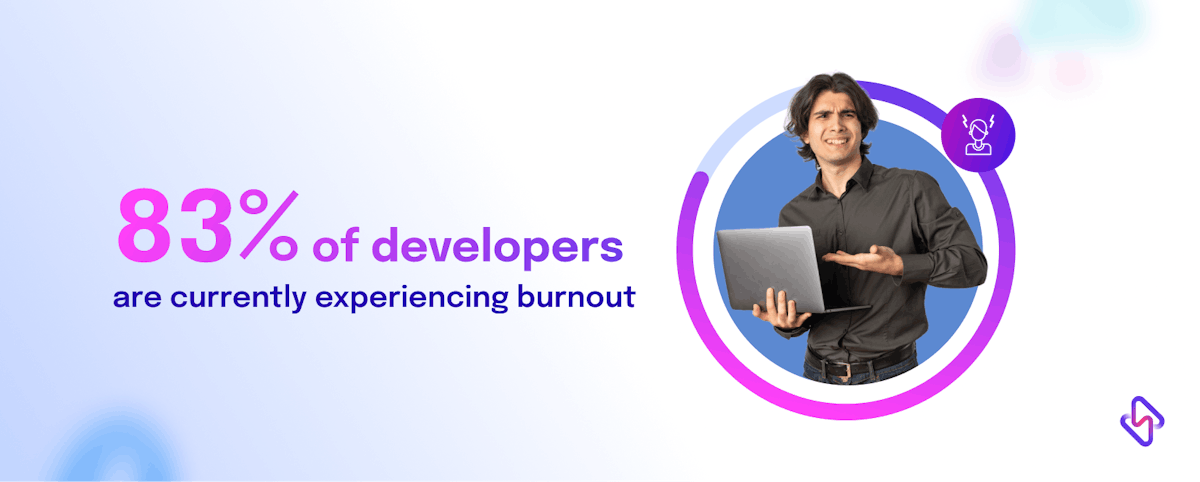Frustrated developers quit, either because of too ineffficient workflows, or because companies only treat them as a technical resource. A resigned workforce is the greatest failure of a company's DX efforts. Even more so, the global dev community is a tightly bound one. A company failing badly with DX can spiral into low developer retention, and troubled future hirings.
One way to retain devs is to remove any toil from their workflow that stops devs from performing their core tasks. It could be anything- reducing meeting overload, building heavy on your Ops/SRE team, or creating internal tools for more efficient workflow. By investing in developer experience, CTOs can build on thriving developers, strike out frustrations from workflows, and retain developer talent.
6. Invest in DevEx To Bring Down Development Costs
Especially as someone leading tech, CTOs have a higher chip on their shoulder when it comes to bringing down costs. Software development amounts to 63% of a project’s budget, leaving engineering with a higher potential to optimize resources.
When workflows are too much loaded with digital tools; they are bound to create complex processes, and devs have hard time fitting themselves. Happy developers can go a long way in minimizing a company’s budget footprint. When a team’s engineering culture is created with developers at center, tons of administrative, and operational tasks are minimized, or delegated to seperate teams, so devs can do their best work.
By investing in DX, hirings and retention become easier. Moreover,when engineering at your workplace is sorted, developers can bring more ideas to the product-business meetings, optimize anything tech that is not working out for them, while ensuring quality product delivery- all in all reducing your product expenses.
7. A Prerequisite to Customer Experience
Companies keep circling back to UX, and they should, since their end-users define the success of what they have built, over months and years. Developers are your first consumers, they test your product, optimize new changes as per client feedback, can think from a user-first approach, and even are potential customers to your final product.
Traditionally, UX, and DX have been at crossroads to each other. However, times are changing. Companies that have figured out DX can quickly adapt to customer demands, and think from a unique user perspective by amalgamating the dev-user persona. By investing in developer experience, organizations can launch faster, and better apps, bring in new products with improved UX, and drill down on quality.
DX, in a way, helps organizations to create a stand-out with business branding so that you never lose on their brand identity. This is exactly what Synk, and Auth0 did. Synk first implemented their product on developers, empowered them to come forward with feedback, and end-users, and asked them to completely own their security infrastructure, rather than getting worked around by a centralized SecOps team. Synk empowered their developers to remove any inefficiency from the current security practices that bogs devs down. The move worked its magic, and Synk through its developer iterations, and insights, managed to achieve a 100% YoY revenue increase.
Get Invested in Your Developers' Experience
There has to be a context change in how a modern enterprise-developer relationship looks like. A healthy work culture for devs is more than free snacks, and foosball tables; rather it is about the overall joy a developer feels while building products and doing what they love doing the most.
Big ships turn slowly, but it doesn’t have to be the case for big techs today. What devs wanted in the early 2000s vs what they need in the 2020s has changed radically. Devs should not just be at the forefront of software development, but should also be the face of cultural and process changes in an organization.
Developer experience is not another tech-buzzword, rather it closely follows a brand’s success trajectory. The payoff for investing in developer experience goes beyond benefits for tech teams, and can even bring the next wave innovation.
Backing developer experience is not a one-time event. The process will take continuous team brainstorming, involvement of every stakeholder- from devs, to CTOs, and CEO, remove blockers, and use data-driven insights. Yet the change is well within our reach, and the RoI is far too great to ignore.
Get invested in your developer’s work today!
Subscribe to the Hatica blog to read more about unblocking developers, and boosting productivity with actionable engineering analytics.






